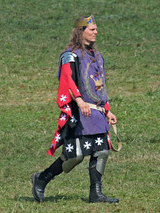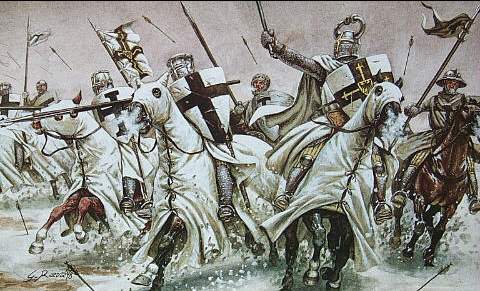 In 1989, in the Kingdom of the East, Duke Sir Andreas Eisfalke formed what is currently known as House Bloodguard.
The household originally started out as an 11th century Norman fighting household. A council of 5 members governed it,
with Duke Sir Andreas acting as chairman and warlord. During the next 2 years the household grew into a very large and
well-known fighting unit, drawing members from all over the kingdom as well as the known world. By 1991, the household
had gained notoriety as an elite unit fanatically loyal to the Kingdom of the East. It was during this time that the
household changed its designation to a 15th century Teutonic German household. The household's governmental structure
also changed at this time. A full ecclesiastical military rank structure was implemented. The rank structure is now
loosely based on the rank structure of the Teutonic order. Since the members of the household are spread throughout
the known world, separate units known as komturies had to be established for organizational accountability. Currently
there are four komturies, which are based within the kingdoms of the East, Midrealm, Trimaris, and Atlantia. All of
these komturies fall under the command of the Grand Master of the order. When traveling afar, a member will fight alongside his brother, loyally guarding the king of the hosting brother.
In 1989, in the Kingdom of the East, Duke Sir Andreas Eisfalke formed what is currently known as House Bloodguard.
The household originally started out as an 11th century Norman fighting household. A council of 5 members governed it,
with Duke Sir Andreas acting as chairman and warlord. During the next 2 years the household grew into a very large and
well-known fighting unit, drawing members from all over the kingdom as well as the known world. By 1991, the household
had gained notoriety as an elite unit fanatically loyal to the Kingdom of the East. It was during this time that the
household changed its designation to a 15th century Teutonic German household. The household's governmental structure
also changed at this time. A full ecclesiastical military rank structure was implemented. The rank structure is now
loosely based on the rank structure of the Teutonic order. Since the members of the household are spread throughout
the known world, separate units known as komturies had to be established for organizational accountability. Currently
there are four komturies, which are based within the kingdoms of the East, Midrealm, Trimaris, and Atlantia. All of
these komturies fall under the command of the Grand Master of the order. When traveling afar, a member will fight alongside his brother, loyally guarding the king of the hosting brother.
In the early part of the decade a few members of the household received the Accolade of Chivalry. First among the peers
of the house is Duke Sir Andreas Eisfalke, the Grand Master of this order. Shortly afterwards, Sir Cadwyd Enwir and Sir
Kurn O'Ferral were recognized as members of the chivalry in their kingdom of Trimaris.
 Many others of the household have been presented with high awards for fighting, service, and the arts. At present, there are over 30 active members in the household, which is spread throughout the known world from the East to Drachenwald, to far off Lochach. A major branch of House Bloodguard is also located in Northshield (MN, WI, ND, SD) and is lead by Duke Lars, Duke Andreas's first squire to become a Knight.
Many others of the household have been presented with high awards for fighting, service, and the arts. At present, there are over 30 active members in the household, which is spread throughout the known world from the East to Drachenwald, to far off Lochach. A major branch of House Bloodguard is also located in Northshield (MN, WI, ND, SD) and is lead by Duke Lars, Duke Andreas's first squire to become a Knight.
Traveling from Pennsic War to Estrella, Lillies, Gulf wars and anywhere else the din of battle is heard, House Bloodguard constantly craves the exultation of battle. Their fierce determination, undying loyalty to kingdom and untiring fight for the cause of righteousness makes House Bloodguard a prized commodity on the field of battle.
Origins of the Teutonic Order
During the Siege of Acre in the Third Crusade a field hospital set up by German merchants and soldiers was formally organized by Duke Frederick of Swabia as a Religious Order under the auspices of local Latin Bishops. Pope Clement III may have recognized the Order as early as 1191, though the evidence is ambiguous. The name and existence of the Order is confirmed in 1196 by an order of papal protection by Pope Celestine III. 1198 saw the Order given a military role in the Levant. A papal bull issued by Pope Innocent III in 1199, affirmed the Orders military role and defined its religious rules. It was to care for the sick in the manner of the Hospitaller Order and in all other business it was to follow the Templar rule and wear the Temple's white cloak with the addition of a black cross. It was initially subordinate to the Master of the Hospitaller Order.
Early History of the Teutonic Order
From its earliest days the Order was involved in countries outside of the Levant.
 Although for over a hundred years they remained a substantial force within the Holy Land, their focus increasingly moved to Eastern Europe. By the time of the fourth Grand Master, Von Salza (1210-39), the Order had holdings that ranged from the Netherlands to the Holy Land. They were substantially involved in Southern Greece, Hungary, Prussia and the Grand Masters had been given a place in The Holy Roman Empire's Diet.
Although for over a hundred years they remained a substantial force within the Holy Land, their focus increasingly moved to Eastern Europe. By the time of the fourth Grand Master, Von Salza (1210-39), the Order had holdings that ranged from the Netherlands to the Holy Land. They were substantially involved in Southern Greece, Hungary, Prussia and the Grand Masters had been given a place in The Holy Roman Empire's Diet.
In 1211 saw the Order invited to establish a presence on the borders of Transylvania by King Andrew of Hungary. Their role was to help in the military defeat and conversion of the Cuman pagans of the area. In 14 years the Order established control over a significant area, sufficient for them to start demanding more and more autonomy from the Hungarian Crown. These demands led to their expulsion in 1225 by force from Hungary. This expulsion coincided with an appeal from Duke Conrad of Massovia against Prussian tribes to the Order for help. The Prussian tribes were pressurizing Northern Polish territories. The offer of cities as fiefs to the Order combined with the Crusade declared against Baltic pagans by Pope Honorius III in 1217 convinced Von Salza to participate. Von Salza also extracted guarantees that any lands conquered by the Order would be theirs to control. The Golden Bull of Rimini confirmed this in 1226 by the Holy Roman Emperor. This conferred Princely rank on the Grand Master of the Order and sovereignty over any Prussian lands captured, to be held as Imperial Fiefs.
Using the resources of their other European holdings and the crusading zeal of many of Europe's senior families, the
Order was able to conquer many of the Prussian, Latvian and Estonian tribes in the space of some 50 years.
 This created large holdings running along much of the south and eastern Baltic coastlines. At the same time the small Order of the Sword, founded by the Bishop of Riga, had successfully conquered large parts of Livonia and Estonia. The Order of the
Sword suffered a major defeat at the Battle of Sauler in 1236. This battle cost the Brotherhood of the Sword its Grand
Master and over a third of their Order Knights. This defeat severely weakened them and threatened their existence. To
survive the mass rebellions brought about by their defeat the Brotherhood of the Sword merged with the Teutonic Order.
The inclusion of the Brotherhood of the Sword greatly increased the holdings of the Teutonic Order. The Order of the
Sword adopted Teutonic insignia and its Grand Master became a Provincial Teutonic Master, though with slightly more
autonomy than normal. The conquest of the coastal areas and control of the Order of the Swords domains changed the
direction of the Crusades.
This created large holdings running along much of the south and eastern Baltic coastlines. At the same time the small Order of the Sword, founded by the Bishop of Riga, had successfully conquered large parts of Livonia and Estonia. The Order of the
Sword suffered a major defeat at the Battle of Sauler in 1236. This battle cost the Brotherhood of the Sword its Grand
Master and over a third of their Order Knights. This defeat severely weakened them and threatened their existence. To
survive the mass rebellions brought about by their defeat the Brotherhood of the Sword merged with the Teutonic Order.
The inclusion of the Brotherhood of the Sword greatly increased the holdings of the Teutonic Order. The Order of the
Sword adopted Teutonic insignia and its Grand Master became a Provincial Teutonic Master, though with slightly more
autonomy than normal. The conquest of the coastal areas and control of the Order of the Swords domains changed the
direction of the Crusades.

